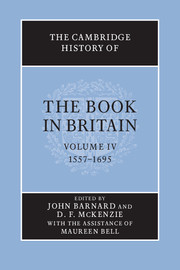Book contents
- Frontmatter
- Dedication
- Contents
- List of illustrations
- List of contributors
- Preface
- Acknowledgements
- Introduction
- RELIGION AND POLITICS
- ORAL TRADITIONS AND SCRIBAL CULTURE
- LITERATURE OF THE LEARNED
- LITERARY CANONS
- 16 Literature, the playhouse and the public
- 17 Milton
- 18 The Restoration poetic and dramatic canon
- 19 Non-conformist voices and books
- 20 Women writing and women written
- VERNACULAR TRADITIONS
- THE BUSINESS OF PRINT AND THE SPACE OF READING
- BEYOND LONDON: PRODUCTION, DISTRIBUTION, RECEPTION
- DISRUPTION AND RESTRUCTURING: THE LATE SEVENTEENTH-CENTURY BOOK TRADE
- STATISTICAL APPENDICES
- Abbreviations
- Bibliography
- Index
- Plate Section
- References
20 - Women writing and women written
from LITERARY CANONS
- Frontmatter
- Dedication
- Contents
- List of illustrations
- List of contributors
- Preface
- Acknowledgements
- Introduction
- RELIGION AND POLITICS
- ORAL TRADITIONS AND SCRIBAL CULTURE
- LITERATURE OF THE LEARNED
- LITERARY CANONS
- 16 Literature, the playhouse and the public
- 17 Milton
- 18 The Restoration poetic and dramatic canon
- 19 Non-conformist voices and books
- 20 Women writing and women written
- VERNACULAR TRADITIONS
- THE BUSINESS OF PRINT AND THE SPACE OF READING
- BEYOND LONDON: PRODUCTION, DISTRIBUTION, RECEPTION
- DISRUPTION AND RESTRUCTURING: THE LATE SEVENTEENTH-CENTURY BOOK TRADE
- STATISTICAL APPENDICES
- Abbreviations
- Bibliography
- Index
- Plate Section
- References
Summary
Literary historians, and in particular feminist literary historians, have in recent years turned their attention to the early modern period in order to track the emergence of women writers into print and to posit a burgeoning market in ‘female literature’. Print’s implication in the development of new literacies, particularly in the context of political and religious upheaval, is discussed elsewhere in this volume by Nigel Smith; here, the focus is on one of those many voices apparently empowered by print. I argue that existing narratives of the relationship between women and printed text in this period would benefit from a historicism sensitive to the material contexts of printing and publishing.
An enquiry of this kind is concerned not only with ‘woman’ as historical/ biological agent but with ‘woman’ as sign. It must look not only to the relationship between the terms ‘woman’ and ‘writer’ but must also consider ‘woman’ as subject-matter for and in print. Prefatory addresses to women dedicatees, to individual women readers and exhortations to women as interest-groups, for example, may be construed as evidence of intended readers (or at least of intended owners or recipients); equally, however, they might be read as part of a rhetorical strategy in which ‘woman’ became a marketing device. There already exist several well-established contexts for the discussion of women’s writing and writing about women in this period: in particular those of feminist literary history; the study of subjectivity; and the variety of theoretical approaches to gender. The value of using the history of the book as the framework for discussion is that it grounds the question of the relationship of woman and printed text in a historicism which offers a multidimensional approach.
- Type
- Chapter
- Information
- The Cambridge History of the Book in Britain , pp. 431 - 452Publisher: Cambridge University PressPrint publication year: 2002
References
- 3
- Cited by



